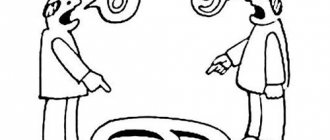You can convey thoughts, feelings and emotions not only through conversations, but also through the body, behavior, gestures and facial expressions. Learning this is not difficult and very useful, because body language will not only help you show or hide emotions in certain cases, but also read the experiences of other people. Body language and body language, the psychology of which has long been studied, can be used in many areas of formal and informal communication, including business, entrepreneurship, negotiations and so on.
Body language and gestures in communication and business
Nonverbal communication in business is very important. It allows you to manage the manifestations of your emotions, adjust them based on the current situation, and use sign language to conduct successful and mutually beneficial negotiations.
Language of the body
Moreover, the ability to “read” the nonverbal behavior of your interlocutor or future partner allows you to understand what his intentions are, whether he is completely honest in his statements and proposals: suddenly he is not telling something, and the body shows this based on the behavioral habits formed throughout life.
The most common manifestations of body language in business are:
- A relaxed handshake, tapping fingers and folding your hands in front of you on the table indicates that the person is confident and knowledgeable in his business;
- If a person leans on a chair or armchair, puts his hands behind his head and looks without taking his eyes off, then he feels smarter and more important than his interlocutor. You need to be careful with such people and avoid harsh statements;
- A person who constantly changes his body position and spins in his chair shows that he is nervous;
- Touching your nose during a conversation may indicate that the interlocutor is lying or not saying something;
- The best hand gesture is open palms. It shows that the person is friendly and open;
- Hands near the face in different poses show a critical attitude to the situation and unjustified expectations and tension.
Business negotiations
Important! Conclusions about postures cannot always accurately determine the behavior and mood of interlocutors. For example, a hand position that indicates tension may be a comfortable, everyday posture that is comfortable for a person.
Distance
A person experiencing tension during a dialogue will try to increase the distance between himself and the interlocutor, even in small things. Even if he deliberately tries not to move away, this can be determined by micromovements.
Pay attention to where your feet and body are pointing. If they are directed towards the interlocutor, then the person is ready to make contact with him. Moreover, he likes him. If they are turned away, then the person wants to quickly end the conversation and leave.
Hand gestures and their meaning
People use their hands most often. Hand gestures and their meaning are given great importance in psychology. There are a huge number of poses with them that signify certain experiences. Here are some of them:
- Open palms mean openness and truthfulness of what was said, trust;
- Closed palms (turned towards you) mean an invitation to mutual understanding and even physical contact;
- "OK" gesture. Here it does not mean agreement, but a sign of pedantry and morality;
- Open palms with bent fingers - the desire for power and dominion;
"Ok" sign - Clasped hands on the legs and face show unfulfilled hopes;
Social intelligence
Social intelligence, which refers to social competence, is considered a basic intellectual ability that is distinct from other cognitive abilities. Associated with social intelligence is the concept of emotional intelligence, which characterizes a person’s ability to evaluate emotional messages, regulate their own emotions and wisely use them to manage their thoughts and actions.
To properly understand other people, you need to pay attention to their characteristics, including appearance and nonverbal behavior. Sometimes the information we get from observing a person is important in itself, regardless of what benefits may be drawn from it
Sometimes, having noticed something, we immediately draw a conclusion, and sometimes we notice something, but understanding does not come immediately.
However, communication skills are not limited to non-verbal messages. The verifier needs to understand the meaning of verbal messages—literal and metaphorical, as well as the nuances of what is read “between the lines”—and integrate verbal and nonverbal cues. It is also necessary to understand social contexts and roles: what is acceptable and what is unacceptable in a particular social situation, how people performing certain roles should behave, and what consequences follow from violating the expectations of others.
Concepts about nonverbal skills can be used to bring new perspective to long-established concepts. Empathy, rapport, adjustment, and leading, along with processes such as social comparison and impression management, can be considered in terms of control over accuracy in sending or receiving nonverbal cues in social interaction.
Our ability to send and receive nonverbal signals is developed in the course of everyday life. We, without realizing it, learn nonverbal behavior by imitating and modeling the behavior of other people, changing our actions taking into account the feedback we receive, and responding to the instructions and advice of others.
A person's nonverbal skills improve through varied experiences decoding feelings and nonverbal cues. Feedback in the form of discussion with participants about when their judgments of nonverbal behavior are correct and when they are incorrect is one of the most effective methods for improving nonverbal skills.
People who understand nonverbal cues and have good nonverbal communication skills are more difficult to manipulate than those who do not have such skills. If those who know a lot about nonverbal behavior begin to be suspected of using their knowledge “against” others, very soon attempts are made to expose them or counter this. It goes without saying that every verifier has an ethical responsibility to not use their knowledge to harm others.
Because verifiers spend a lot of time observing others—either passively (only observing) or actively (observing and interacting)—they somehow develop good skills in decoding the nonverbal messages of the observed objects.
Without a doubt, nonverbal cues are a critical element of our communication efforts.
Sometimes they become the most important part of the messages we send. Understanding and effectively using nonverbal behavior is critical to achieving success in virtually all social interactions we engage in
Open and closed poses
When communicating, a person can use open and closed postures, which have different effects on the attitude of the interlocutor.
An open pose is a pose that does not involve crossing your arms. The palms should be facing the partner or open. The body is not bent and turned towards the interlocutor.
Important! All processes in the human body are interconnected, so if the interlocutor does not trust someone, he becomes clamped, his limbs are pressed against the body, his arms are crossed at the hands or elbows, the gestures of his hands and feet are constrained. A trusting person who feels comfortable, does not hold back and behaves openly. This does not depend on gender: men and women show aggression and sadness in the same way.
Open and closed postures when meeting
A closed pose is a pose in which a person seems to fence himself off from people or defend himself. This most often manifests itself in crossing arms and legs, as well as turning the body away and lowering the eyes, touching a finger, various objects, and resting on the floor.
Other factors
Posture can easily be influenced by poor health and other factors. Thus, any use of posture to assess personality, character, psychology must first rule out possible underlying medical conditions that may affect a person's posture. In addition, there is evidence suggesting that one maintains his or her position is worse if he or she listens to sentences that describe the actions of others. For example, if your task is to keep your posture strictly in a state, you do it worse when you listen to sentences like this: “I get up, put on my slippers, go to the toilet.”
How to recognize body language
It is difficult to fake body language, and to learn to recognize it, you just need to be attentive. To date, many books have been written on determining nonverbal behavior and controlling emotions. I can recommend the book “Body Language. How to Read the Minds of Others by Their Gestures by Allan and Barbara Pease, and I See What You're Thinking by Joe Navarro.
In order to learn to recognize gestures and postures, you need to carefully monitor:
- the position of the interlocutor's head;
- his facial expressions;
- arms and legs;
- closed and open postures, under what conditions they appear;
Gestures - emotions.
Scientific research
Representatives of Ancient Rome already possessed the study of body language and the desire to characterize gestures. The science formed on the basis of the observations of researchers was called kenesics. The greatest contribution to its development was made by:
- J. Balwer. He created a fundamental work devoted to gestures, in particular, hand movements.
- I. F. Lavater. He studied physiognomy and conducted a comparative analysis of emotions and gestures.
- G. K. Lichtenberg. He published several works in which he examined Lavater’s ideas in detail, calling them superficial and far from reality.
- C. Bell. He studied the nervous system, studied the correspondence of facial features to the emotions experienced. He deduced a pattern between emotional reaction and muscular activity.
- C. Darwin. Studied the correspondence of facial expression to emotional reaction.
- F. Bacon. I came to the conclusion that there is a special body language that is understood by all peoples of the world.
- F. Lowen. In his book on the psychology of the body, he outlined the basics of psychosomatic problems
Psychologists and sociologists believe that body language can become a universal means of communication between people of different social groups.
Undesirable postures when communicating with an interlocutor
All of the postures described below are undesirable and should be eradicated when communicating not only during business negotiations, but also during normal communication, even with strangers:
- Crossed arms on the chest or on the hips - aggression and protection;
- “Footballer’s Pose” – protection and weakness;
- Interlacing hands behind the back - fear;
Poses - The position of the hands in the pockets indicates excitement and nervousness;
- Leaning back in a chair means distrust and disagreement.
Eye contact
The “language of gaze” is very diverse. Thus, completely open eyes characterize high receptivity of feelings and reason, general liveliness. Eyes that are too wide open/"bulging"/ indicate an increase in optical attachment to the surrounding world. Closed, “curtained” eyes are often a sign of inertia, indifference, arrogance, boredom or severe fatigue
A narrowed or squinted gaze means either concentrated close attention /observation/, or /in combination with a side glance/ cunning, cunning. A direct gaze, with the face fully turned towards the partner, demonstrates interest, trust, openness, readiness for direct interaction
A sideways glance, from the corners of the eyes, indicates a lack of full dedication, skepticism, and mistrust. A look from below (with a bowed head) indicates either an aggressive readiness for action, or (with a bent back) subordination, humility, and helpfulness. Looking from top to bottom / with the head thrown back / reveals a feeling of superiority, arrogance, contempt, and the search for dominance. An evasive gaze indicates uncertainty, modesty or timidity, and possibly a feeling of guilt.
The corners of the mouth drawn down symbolize a generally negative attitude towards life, a general sad expression on the face. Raised corners of the mouth reflect a positive attitude towards life, a lively and cheerful expression. If the mouth appears plump, it indicates increased vitality of the senses; soft - for sensitivity; sharp, precisely carved - for intelligence; firm - for certainty of will.
What Gestures Should You Avoid?
Gestures show the strength of emotions experienced and experienced by a person. You can be angry and express it demonstrably, or you can be very angry, waving your arms left and right. As in the case of postures, tense, complex, distrustful and aggressive gestures should be avoided. The main ones include:
- Index finger - accusation;
- Thumb – superiority and not being taken seriously;
- Fist - aggression;
Aggression poses - Touching the nose, lips and face during a conversation - excitement and lies;
- Touching the ear means mistrust and prejudice.
General methods
Physical postures and emotions were studied using two similar methods. The first method involves the participant watching video footage of actors performing certain actions, while the second method involves having the participant sit in a certain position and then self-report their emotions. In the first method, actors portray and record specific body movements. Participants must watch the video and decipher the emotions they think are being portrayed. In the second method, participants are told to assume a certain posture and then have to fill out a questionnaire on their current state of affect. Other methods include using neuroscience techniques such as fMRI to determine how posture and emotional expression can affect brain scans. Another method that is growing in use involves using dancers as "actors" and having participants observe and determine the dancer's emotion in an assembly line.
Facial expressions when communicating, what should not be demonstrated
Facial expressions play one of the central roles in communication. First of all, when meeting someone, they look at the face, at the emotions that are displayed there. It’s not for nothing that the science called physiognomy has become so popular. The following facial expressions are undesirable:
- Frown eyebrows - mistrust, aggression and anger;
- Raised eyebrows – surprise coupled with reluctance to communicate;
- Yawning is indifference to the interlocutor and his words;
- Grin - an evil coloring of behavior and aggression;
- A wrinkled nose and protruding lips are disgust.
Learning body language and body language is not very difficult, and it gives a huge psychological advantage both in simple communication and in mutually beneficial negotiations. A person who has these skills and understands what his interlocutors are hiding or trying to say can always turn the conversation in a direction beneficial to himself. Having learned to behave correctly, a person will also be able to win over his interlocutor, show him his sincere respect, and establish complex contacts and partnerships.
Kinesics
Kinesics is a branch of psychology that studies human emotional reactions from the point of view of his expressive movements (body movements). In this aspect, the following are considered as the main non-verbal means of communication: posture, expressiveness of gestures, facial expressions, gait features, gaze. It is believed that the information that the interlocutor wants to convey through speech may differ significantly from the feelings he actually experiences.
Pose
The postures a person takes during a conversation indicate his true intentions, more eloquently than gestures and facial expressions. Coping with your emotions is easy, but controlling postures when communicating is more difficult.
Modern psychologists divide postures into three types:
- Dominance - a person hangs over, tries to look down from above, sits leaning back, crossing his legs. Dependency – the individual lowers his head, sits with his knees tightly clenched, fiddling with his fingers.
- Closedness - the opponent clasps his fingers, closes himself by crossing his arms and legs, moves away from the interlocutor, and looks away. Openness - an individual who is inclined to communicate is distinguished by a relaxed posture, a wide smile, open palms, outstretched legs, and the torso turned towards the interlocutor.
- Confrontation is expressed by a raised chin, clenched fists, arms outstretched or placed on the hips, sides. Harmony is manifested in the speaker’s peaceful posture and good-natured gaze.
Gestures
With the help of these non-verbal elements of communicative communication, our ancestors have been trying to achieve mutual understanding since ancient times. Head movements and hand gestures can convey the emotional state of the interlocutor - his overexcitation, sadness, joy, anger, etc.
In the non-verbal sense, sign language is classified into the following types:
- modal – conveying the attitude of the conversation participants (trust/distrust, approval/disagreement, satisfaction/dissatisfaction);
- communicative - used for prohibitions, approval, farewell, greeting, attracting attention, etc.
- descriptive - express emotional coloring in the context of certain statements.
Facial expressions
Facial reactions are considered one of the main indicators of the true feelings of the interlocutor. According to research, if an individual maintains a still face, then information about his personal characteristics is lost by 15%. Psychologists have noted more than 20,000 different nonverbal interpretations of facial expressions. The main emotional states are:
- anger;
- fear;
- irritation;
- sadness;
- astonishment;
- joy;
- disgust.
When a person’s emotional state changes, the configuration of the entire face begins to dynamically change, mainly the lips, eyebrows and forehead.
Gait
The gait personifies the individual's position in life. By analyzing a person’s style of movement, one can judge the characteristics of his character, age, well-being and even profession. By the dynamics, rhythm and amplitude of the step, psychologists learn about such states as pride, suffering, illness, anger, determination, happiness, etc. A “light” gait indicates high spirits, joy, and self-confidence. “Heavy” – typical for gloomy people who are despondent or in a state of anger. “Sluggish”, “sluggish” - happens in suffering, insecure people.
Sight
Eye contact is a non-verbal signal that is the most important element in the art of communication. A direct, interested look endears the interlocutor and arouses sympathy. Looking too long is perceived as a challenge, excessive interest of the interlocutor. A short one, on the contrary, gives reason to believe that the opponent is insincere and is hiding information. It is considered optimal to exchange glances for 10 seconds.
It is also worth taking into account the national factor, for example, Asians (Japanese, Koreans) do not often look at faces, Europeans are distinguished by their direct gaze. Depending on the specifics, psychologists distinguish the following types of views:
- social – typical for secular, relaxed communication;
- business – used in a working atmosphere (when concluding business contracts, interviews, etc.);
- intimate – personifies interest, love, etc.;
- a sideways glance may indicate hostility, envy, criticism, or suspicion.
The eyes are capable of transmitting the most subtle signals of an individual's emotional state. Constriction/dilation of the pupils occurs in a person at an unconscious level, depending on his mood and state of the body. An excited person interested in something will have pupils dilated 4 times. A gloomy, depressive state leads to constriction of the pupils.
Tactile movements
Embrace
The meaning of the expressed feelings is determined by the nature of the hug, its duration and strength. For example, bosom friends who have not seen each other for a long time literally strangle each other in their arms when they meet. At wrestling competitions, participants briefly hug and quickly return to their respective corners. Lovers linger in a tender embrace for a long time, clinging together, demonstrating serene happiness, clinging tightly - passion or the fact that they miss you. The hugs of distant relatives depend on previously maintained relationships; they can be cold, reserved, or passionate. The hugs of loved ones are soft and sincere.
Handshakes
The open palm has long been a gesture of trust. The handshake itself dates back to ancient times: primitive people shook hands to demonstrate that they were not armed and were peaceful. And during the heyday of the Great Roman Empire, this gesture changed somewhat - people began to shake hands by the wrists. The common habit of hiding a dagger in the sleeve played a role, but the meaning is the same: to show good disposition, the absence of hidden weapons.
Such a gesture is firmly entrenched in our subconscious and we, just like our ancestors, extend our hands to each other as a sign of trust, or try to hide our palms when we are hiding something.
By vigorously shaking your hand combined with a joyful exclamation, you can easily determine the sincerity of your interlocutor and his desire to continue communication. When they clasp a hand with both of theirs, in the form of a “glove,” they also demonstrate friendliness. But when they offer you a “lifeless”, limp hand, it means that they don’t want to contact you.
If the hand is cold when shaking, then this is a signal that its owner is cold, or is seriously excited. Steamy palms also indicate a nervous experience. When, when shaking, the hand turns out to be palm down, this indicates the desire of its owner to dominate the other person. On the contrary, a hand turned palm up communicates that a person unconsciously recognizes himself as a subordinate and agrees to be led in relations with his interlocutor.
Patting on the shoulder or back
These nonverbal gestures are very typical for men. They often symbolize friendship, encouragement, or concern. In addition, patting the shoulder or back demonstrates masculine strength, the ability to support in a difficult situation, and the willingness to help if necessary.
Touch
Touches can be light, affectionate, gentle, strong, rough. Nonverbal communication and touching gestures are most common in relationships that are intimate or involve strong emotions.
Stopping touches - when you need to stop a mischievous mischief-maker
Attracting attention - when the interlocutor does not hear or does not want to listen. Intimating in an intimate mood - in the case of sexual foreplay
Very often, touches are an indicator of the unexpressed feelings of a loved one: tenderness, care, love, disagreement, irritation, aggression.











